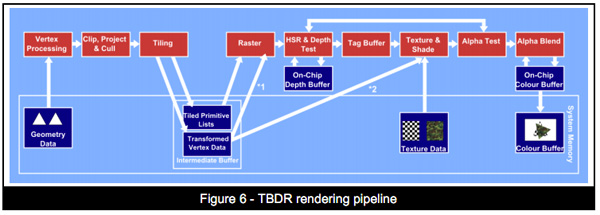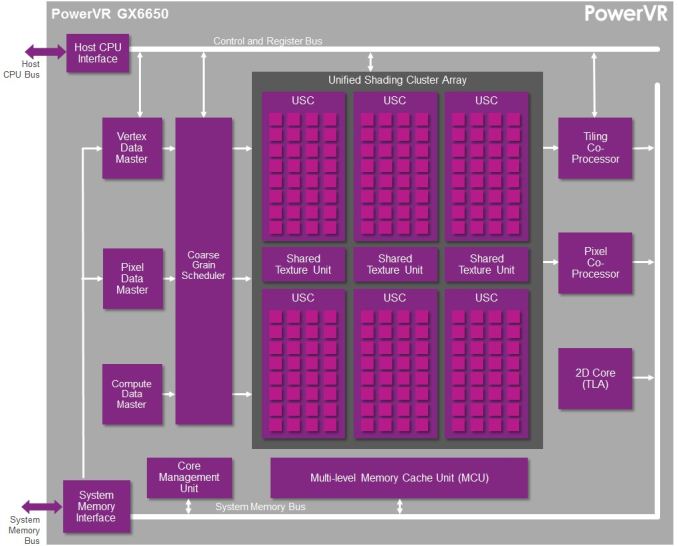Imagination's PowerVR Rogue Architecture Explored
by Ryan Smith on February 24, 2014 3:00 AM EST- Posted in
- GPUs
- Imagination Technologies
- PowerVR
- PowerVR Series6
- SoCs
Technical Comparisons
Finally, to close out this look at the Rogue architecture we wanted to spend a bit of time looking at how it compares to other architectures. Unfortunately the lack of details we have on other SoC GPU architectures means we can’t make any meaningful comparisons there beyond the GFLOPs comparisons we do today (and that says nothing of real world efficiency). But we can compare it to the next best thing, which is mobile parts based on desktop GPU architectures from AMD and NVIDIA. The latter case being especially interesting, as we know Kepler will be coming to SoCs with the K1.
With that said, and we can’t reiterate this enough, this is just a look at theoretical performance. It is not possible to take into account efficiency measures such as memory bandwidth, ROPs, or especially early rejection optimizations such as Tile Based Deferred Rendering. TBDR is Imagination’s ace, and while other GPU firms have their own early rejection technologies, from what little we know about each of them, none of them quite matches TBDR. So Rogue’s theoretical performance aside, if Imagination is rejecting significantly more work before it hits their shaders, then they would have greater performance when all other factors were held equal. The only way to compare the real world performance of these architectures is to benchmark their real world performance, so please do not consider this the final word on performance.
For this comparison we’ll be looking at NVIDIA’s Kepler based K1, AMD’s GCN based A4-1350, and Imagination’s Rogue based GX6650 and G6230. Because Rogue is offered in multiple configurations it’s difficult to determine just how large a Rogue configuration would equal K1 or A4-1350 from a performance and size perspective, but given the anticipated integration time for Series 6XT, a 6 cluster configuration seems the most likely.
| GPU Specification Comparison | |||||||
| NVIDIA K1 | Imagination PVR GX6650 | Imagination PVR G6230 | AMD A4-1350 | NVIDIA GTX 650 | |||
| FP32 ALUs | 192 | 192 | 64 | 128 | 384 | ||
| FP32 FLOPs | 384 | 384 | 128 | 256 | 768 | ||
| Pixels/Clock (ROPs) | 4 | 12 | 4 | 4 | 16 | ||
| Texels/Clock | 8 | 12 | 4 | 8 | 32 | ||
| GFLOPS @ 300MHz | 115.2 GFLOPS | 115.2 GFLOPS | 38.4 GFLOPS | 76.8 GFLOPS | 230.4 GFLOPS | ||
| Architecture | Kepler | Rogue (6XT) | Rogue (6) | GCN 1.0 | Kepler | ||
Briefly, we can see that as far as theoretical shading performance is concerned, both the GX6650 and K1 are neck-and-neck when clockspeeds are held equal. Both of them have the same ILP dependency, so both need to be able to pull off some FP32 co-issued instructions if they are to achieve their full 384 FLOP/cycle throughput. The A4-1350 on the other hand has no such limitation, making it easier to hit its 256 FLOP/cycle throughput, but never getting the chance to go past it.
Meanwhile it was surprising to see that GX6650’s theoretical pixel throughput was so high. 12 pixels/clock (12 ROPs) is much higher than either K1 or A4-1350, and in fact is quite high for an SoC class product. Most designs use relatively few ROPs here for size and power reasons, and not all designs replicate the ROPs with the shader blocks. So having 12 ROPs here was unexpected. At the same time it remains to be seen how well real world efficiency tracks this, as ROPs are frequently memory bandwidth constrained, which makes such a large number of ROPs harder to feed.
Moving on to quickly compare texture throughput, again it’s surprising to see just how many texels GX6650 can push. TMUs regularly scale with shader core counts, so the fact that it’s three-fold what a single TMU design can do is not unexpected, but until now we had never realized just what that meant for overall texture throughput. 12 texels/clock is (thankfully) a lot of texels for a SoC GPU. That said, this is also a memory bandwidth heavy operation, so it’s difficult to say how real world performance will track it.
Finally, to throw in a true desktop comparison for the fun of it, we also put NVIDIA’s Kepler based GTX 650 in the chart. Clockspeeds aside, the best case scenario for even GX6650 is that it achieves half the shading throughput as GTX 650. The ROP throughput gap on the other hand is narrower (but GTX 650 will easily have 2x the memory bandwidth) and the texture throughput gap is nearly 3x wider. In practice it would be difficult to imagine the GX6650 being any closer than about 40% of the GTX 650’s performance, once again owing to the massive memory bandwidth difference between an SoC and a discrete GPU.
Final Words
Wrapping up this architectural overview of Imagination’s Rogue architecture, it’s exciting to finally see much of the underpinnings of an SoC GPU design. While we haven’t seen every facet of Rogue yet – and admittedly it’s unlikely we ever will – the information that we’ve received on Rogue so far has given us a much better perspective on how Imagination’s latest graphics architecture works, and for that matter how Series 6 and Series 6XT differ from one-another.
Ultimately we still can’t do true apples-to-apples comparisons with these integrated GPUs (we can’t separate the CPU and memory controller from the GPU), but it should be helpful for better understanding why certain products perform the way they do, and determining what the stronger products might be in the long run. So it’s with some hope and a bit of luck that this might get the ball rolling with the other SoC GPU vendors, getting them to open up their doors a bit more so that we can see what’s inside their designs.
Coming back full circle to Imagination, we’re left with one of the big reasons why they’re opening up in the first place: core wars. Imagination is keen on not being seen as being left behind on core counts, and while we don’t expect the “core” terminology to go away any time soon, now that we have these low level Rogue architecture details, we can agree that Imagination does have a salient point as far as counting cores and ALUs is concerned.
For the purposes of FP32 operations a Rogue USC is essentially equivalent to a 32 core design, with an ILP reliance similar to what we’re seeing out of NVIDIA right now, though perhaps greater than some other designs. Or as Imagination likes to compare it to, a 6 USC design would be equivalent to a 192 core design. This speaks nothing of real world performance – without real world hardware it can’t, there are too many external variables – but it does give us an idea of how many clusters Imagination’s customers would need to achieve various degrees of theoretical performance, including what it would take to beat the competition.












95 Comments
View All Comments
Sonicadvance1 - Tuesday, February 25, 2014 - link
Thanks for the response. Good to know. The article didn't really note anything about it.ryszu - Tuesday, February 25, 2014 - link
I misspoke actually, integer is a separate pipe in Rogue.Sonicadvance1 - Thursday, February 27, 2014 - link
Alright, then how much slower is Integer performance compared to floating point? Integer performance is an area that Nvidia struggles with as well.MrSpadge - Saturday, March 1, 2014 - link
This sounds different from any material Ryan showed or discussed. Could you elaborate, may directly to Ryan and have him update the article?Frenetic Pony - Monday, February 24, 2014 - link
I'm not sure what exactly is being babbled on about with tile based deferred rendering. It's just software, anyone can write and run it. Go onto a friendly GPU programming forum and they'll take you through it step by step.Scali - Monday, February 24, 2014 - link
Deferred rendering is a software solution. Tile-based deferred rendering is a hardware solution. The GPU cuts up the triangles in a set of tiles. Inside the GPU, there is a superfast 'framebuffer' the size of a tile (think of a special L1-cache). The GPU renders one tile at a time into this buffer, solving overdraw very quickly and efficiently, then it burst-writes the tile out to the framebuffer in videomemory. PowerVR has been using this technology since the early days of 3D acceleration (I have a PowerVR PCX2 card myself, and did a blog on it a while ago: http://scalibq.wordpress.com/2012/12/18/just-keepi...I suggest you read up on it, it is very interesting technology, and unlike any competing GPU.
Frenetic Pony - Monday, February 24, 2014 - link
No it isn't. Anyone with the proper feature set can do tile based deferred, most next gen games are going to be culling light lists out on something like an 8x8 pixel per tile basis, whether that's for forward rending or deferred. Which sounds exactly like what you described.It might be nice that there's some special little cache for it in PowerVr. But the basic idea as you've described it sounds exactly the same in principle as what DICE/EA's Frostbite does, as well as any number of other papers and games coming do.
Scali - Monday, February 24, 2014 - link
No, I don't think you quite get it. Culling lights in tiles is something different.In this case the geometry is batched up before drawing, then binned to tiles, and then the visibility (z-order) is solved on a per-tile basis.
It may sound the same as deferred rendering tricks in software, but it is not quite the same. These software tricks depend on multiple rendering passes, with z/stenciltesting to determine which pixels to shade. PowerVR can do it in a single pass (as far as the software is concerned).
Again, I suggest you read up on it.
Scali - Monday, February 24, 2014 - link
In fact, the PowerVR PCX2 card did not even need a z-buffer in videomemory at all. What "feature set" on a regular GPU would be able to render properly without a z-buffer?MrPoletski - Sunday, March 9, 2014 - link
Exactly, the Z-buffer is on chip. Incidentally, Multi-sampling AA increases your Z-buffer and framebuffer bandwidth requirements by a factor of x (for 4x AA). What if that were all on chip?I can't believe IMGTEC haven't made more noise about this.